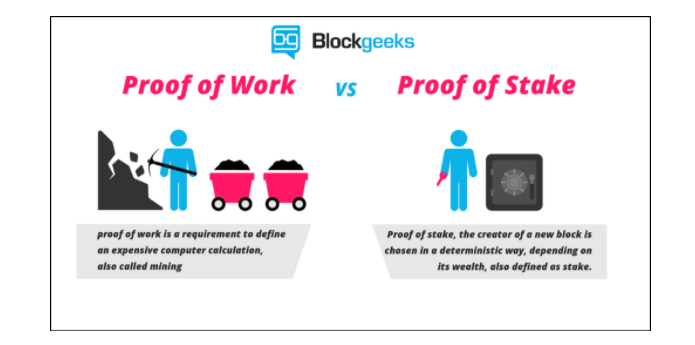Ethereum is in a very interesting stage right now. Having gone through numerous battles like the DAO attack and the subsequent hardfork, it is finally at a stage where it can truly expand and become something that is completely unique. In this article, we shall be discussing the upcoming changes that will be happening to Ethereum and what its future looks like.
The change from proof of work to proof of stake

The biggest change that needs to be talked about first and foremost is Ethereum’s shift from proof of work to proof of stake. We will not go deep into the explanation but it is important to have a general idea.
Proof of work: This is the protocol that most cryptocurrencies like Ethereum and Bitcoin have been following so far. This means that miners “mine” cryptocurrencies by solving crypto-puzzles using dedicated hardware.
Proof of stake: This protocol will make the entire mining process virtual. In this system we have validators instead of miners. The way it works is that as a validator, you will firstly have to lock up some of your ether as stake. After doing that you will then start validating blocks which basically means that if you see any blocks that you think can be appended to the blockchain, you can validate it by placing a bet on it. When and if, the block gets appended, you will get a reward proportional to the stake you have invested. If, however, you bet on the wrong or the malicious block, the stake that you have invested will be taken away from you.
To implement “proof of stake” Ethereum is going to use the Casper consensus algorithm. In the beginning it is going to be a hybrid style system where majority of the transactions will still be done proof of work style while every 100th transaction is going to be proof of stake. What this will do is that it will provide a real world test for proof of stake on Ethereum’s platform. But what does that mean for Ethereum and what are the advantages of this protocol? Let’s take a look.
Advantages of proof of stake
- Lowers the overall energy and monetary cost: The world’s bitcoin miners spend around $50,000 per hour on electricity. That’s $1.2 million per day, $36 million per month and ~$450 million per year! Just put your head around those numbers and the amount of power being wasted. By using “Proof-of-stake” you are the making the whole process completely virtual and cutting off all these costs.
- No ASIC advantage: Since the whole process will be virtual, it wouldn’t depend on who has the better equipment or ASICs (application-specific integrated circuit).
- Makes 51% attack harder: 51% attack happens when a group of miners gain more than 50% of the world’s hashing power. Using proof of stake negates this attack.
- Malicious-free validators: Any validator who has their funds locked up in the blockchain would make sure that they are not adding any wrong or malicious blocks to the chain, because that would mean their entire stake invested would be taken away from them.
- Block creation: Makes the creation of newer blocks and the entire process faster. (More on this in the next section).
- Scalability: Makes the blockchain scalable by introducing the concept of “sharding” (More on this later.)
How does this help in scalability.Introducing proof-of-stake is going to make the blockchain a lot faster because it is much more simple to check who has the most stake then to see who has the most hashing power. This makes coming to a consensus much more simple. Plus, implementing a “proof of stake blockchain” is an integral part of Serenity, the 4th and final form of Ethereum (more on this in a bit.)
As of right now, Casper stage one is going to be implemented on the blockchain, wherein every 100th block will be checked via proof-of-stake. Yoichi Hirai from Ethereum foundations has been running casper scripts through mathematical bug detectors to make sure that it is completely bug free.
Eventually, the plan is to move majority of the block creation through proof-of-stake and the way they are planning to do that is….by entering the ice age. The “ice age” is a difficulty time bomb which is going to make mining exponentially more difficult. Having an impossibly high difficulty will greatly reduce the hash rate which in turn will reduce the speed of the entire blockchain and the DAPPS running on it. This will force everyone involved in Ethereum to move on to proof-of-stake.
However, this entire transition is not without its obstacles. One of the biggest fears that people have is that miners may forced a hardfork in the chain at a point before the ice age begins and then continue mining in that chain. This could be potentially disastrous because that would mean there could be 3 different chains of Ethereum running at the same time: Ethereum classic, Ethereum proof of work and Ethereum proof of stake.
This is currently all speculation. For now, the fact is that, for a scalable model, it is critical for Ethereum to use proof of stake to get the speed and the flexibility it requires.
The change to Metropolis
The complete launch process of Ethereum was divided into 4 phases. This was done to make sure that various stages got its own developmental time and that every phase was developed as efficiently and optimally as possible. The 4 phases are as follows:
- Frontier phase: This was what everyone got when Ethereum was first launched.
- Homestead phase: The phase that we are on as of writing.
- Metropolis phase: The upcoming phase.
- Serenity phase: The final phase.
The event that everyone is expecting any time now is the start of the metropolis phase. Before we even begin explaining the upcoming phases it is important that we know what the following three terms mean:
- Abstraction.
- Zk-Snarks.
- Sharding.
Abstraction: This means that anyone can use any system or protocol without completely knowing the ins and outs and all the technical details. Eg. When you use your iPhone, you don’t need to be a programmer or an engineer to operate it. You simply press on the screen to activate an app, or press on the call button to call someone. You don’t need to know how pressing certain apps activates the circuit inside the phone or how certain apps were programmed. That, in a nutshell, is what abstraction means, making a complex technology accessible to the masses by removing the complexities.
Zk-Snarks: Zk-Snarks stands for “Zero-Knowledge Succinct Non-interactive Argument of Knowledge”. Zk-Snarks is based on zero knowledge proofs which works something like this: There are two parties, the prover and the verifier, the prover can prove that they are party to a certain information to the verifier, without revealing the information itself. This greatly aids in privacy.
Sharding: Sharding basically means breaking down a huge database (like a blockchain) into smaller and more manageable parts called “shards”. Each shards gets its own set of validators (which is why proof of stake is a pre-requisite to making this happen). The way sharding helps scalability is very straight-forward. As of right now, in the proof of work model, all the miners are working on the same problem at the same time. By sharding, and separating the validators into their designated shards, you are making sure that they are all working on different problems at the same time. This makes the whole system much more efficient.
The four main things that are going to be implemented in the Metropolis phase are:
- Implementing various EIPs (Ethereum Improvement Protocols) which will make Ehtereum more robust.
- Flexibility to smart contracts: The smart contracts will be able to pay their own fees without the need of users funding them externally.
- Initial steps towards abstraction: The first steps towards abstraction and making Ethereum more “masses-friendly” will be taken. A possible innovation is allowing users to pay for Ethereum transactions via any cryptocurrency, including bitcoin.
- The introduction of Zk-Snarks.
This is the immediate upcoming update for Ethereum, however, as we have discussed, there is one more phase.
Serenity
This one is way down the line but it is the final and true form of Ethereum. This is what will happen when Serenity finally gets launched:
- Implementing even more EIPs.
- Complete change from proof of work to proof of stake.
- Complete abstraction of Ethereum.
- Implement blockchain sharding. This will make the blockchain, the transactions and consequently, the DAPPS running on Ethereum run much faster. Using blockchain sharding will exponentially decrease block creation time as well. It is said that every new block could be added in < 4seconds.
With all these changes and updates, the future definitely looks bright. What Ethereum ultimately wants to do is to “disappear”. This means that it wants to be omnipresent and run on everything without people even knowing they are currently working on something based on Ethereum. There is still a long way to go before they can even attempt to achieve that, but the future definitely looks bright.
